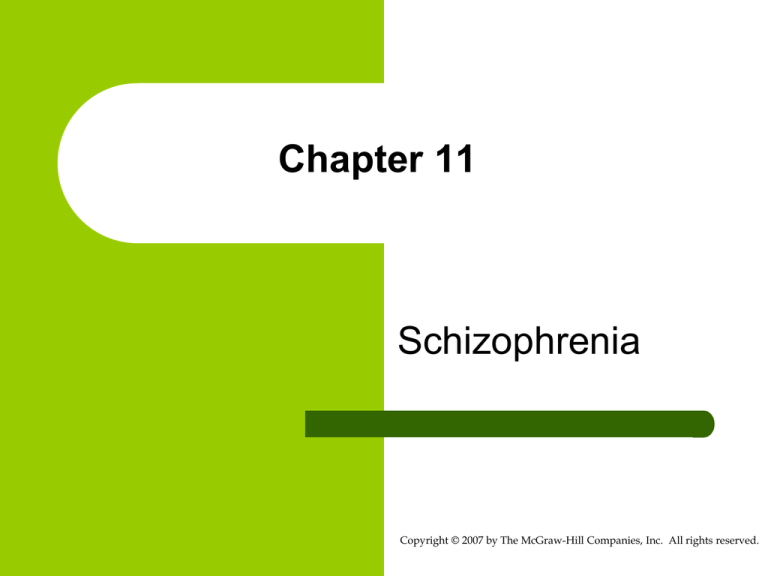
Chapter 11
Schizophrenia
Copyright © 2007 by The McGraw-Hill Companies, Inc. All rights reserved.
Schizophrenia
Chapter 11
Copyright © 2007 by The McGraw-Hill Companies, Inc. All rights reserved.
DSM-IV Criteria for Schizophrenia
A. Core
symptoms: two or more of the following present for
at least a 1-month period
1. Delusions
2. Hallucinations
3. Disorganized speech
4. Grossly disorganized or catatonic behavior
5. Negative symptoms
Chapter 11
Copyright © 2007 by The McGraw-Hill Companies, Inc. All rights reserved.
DSM-IV-TR Criteria for Schizophrenia,
continued
B. Social/occupational functioning: significant impairment in
work, academic performance, interpersonal
relationships, and/or self-care
C. Duration: continuous signs of the disturbance for at least
6 months; at least 1 month of this period must include
symptoms that meet Criterion A.
Chapter 11
Copyright © 2007 by The McGraw-Hill Companies, Inc. All rights reserved.
Positive Symptoms: Type I
Delusions
–
–
–
–
Persecutory
Delusions of Reference
Grandiose Delusions
Delusions of Thought Insertion
Hallucinations
Disorganized Thought and Speech
Disorganized or Catatonic Behavior
Chapter 11
Copyright © 2007 by The McGraw-Hill Companies, Inc. All rights reserved.
Negative Symptoms: Type II
Affective Flattening (or Blunted Affect)
– Severe reduction or complete absence of
affective (emotional) responses to the
environment
Alogia
– Severe reduction or complete absence of speech
Avolition
– Inability to persist at common, goal-oriented tasks
Chapter 11
Copyright © 2007 by The McGraw-Hill Companies, Inc. All rights reserved.
Schizophrenia Disorganized Type
Chapter 11
Copyright © 2007 by The McGraw-Hill Companies, Inc. All rights reserved.
Chapter 11
Copyright © 2007 by The McGraw-Hill Companies, Inc. All rights reserved.
The diathesis-stress model
Diathesis = pre-existing aspect
of person that confers risk of
disorder
Genetic risk--usually not
100%
Psychological diatheses also
Chapter 11 possible
Copyright © 2007 by The McGraw-Hill Companies, Inc. All rights reserved.
The diathesis-stress model
Stressful experience = trigger for
emergence of disorder in
vulnerable individual
Could be a diathesis-specific
stressor
Could be a disorder-specific
stressor
Chapter 11
Copyright © 2007 by The McGraw-Hill Companies, Inc. All rights reserved.
The diathesis-stress model
buffer = characteristic of
individual or environment that
reduces risk
Contextual resources such as
support network
Individual characteristics such
as optimism, coping skills
Chapter 11
Copyright © 2007 by The McGraw-Hill Companies, Inc. All rights reserved.
Biological Theories of Schizophrenia
Genetic Theories
–
Disordered genes cause schizophrenia, or at least
a vulnerability to schizophrenia
Structural Brain Abnormalities
–
Enlarged ventricles, reduced volume and neuron
density in frontal cortex, and other brain
abnormalities cause cognitive and emotional
deficits
Chapter 11
Copyright © 2007 by The McGraw-Hill Companies, Inc. All rights reserved.
Chapter 11
Copyright © 2007 by The McGraw-Hill Companies, Inc. All rights reserved.
Biological Theories of Schizophrenia,
continued
Birth Complications & Prenatal Viral
Exposure
–
Particularly those involving loss of oxygen that
could damage brain
Neurotransmitter Theories
–
Imbalances in levels of or receptors for dopamine
cause symptoms; serotonin, GABA, and glutamate
may also play roles
Chapter 11
Copyright © 2007 by The McGraw-Hill Companies, Inc. All rights reserved.
Prognosis of Schizophrenia
Age and Gender Factors
–
–
Life-span development and stabilization
Women who develop schizophrenia have a more favorable
course of the disorder than do men who develop
schizophrenia
Sociocultural Factors
–
–
–
Differences between developing and industrialized
countries
Acceptance of deviant behavior
Social response and treatment availability
Chapter 11
Copyright © 2007 by The McGraw-Hill Companies, Inc. All rights reserved.
Psychosocial Perspectives on
Schizophrenia
Social drift and urban birth
Stress and relapse
Psychodynamic theory
Communication patterns
Cognitive theories
Behavioral theories
Chapter 11
Copyright © 2007 by The McGraw-Hill Companies, Inc. All rights reserved.
Treatments for Schizophrenia
Biological Treatments: ECT, Antipsychotic drugs
(Phenothiazines, Butyrophenones, Dibenzodiazepines,
Thioxanthenes, Benziosoxazoles, Dibenzoxapines,
Indoles, Diphenylbutylpiperidines)
Behavioral, Cognitive, and Social Interventions:
Recognition of demoralizing attitudes they may have
toward their illness, operant conditioning, modeling,
family therapy, token economies, self-help groups,
assertive community treatment programs.
Chapter 11
Copyright © 2007 by The McGraw-Hill Companies, Inc. All rights reserved.
Treatments for Schizophrenia, continued
Cross-Cultural Treatments: Cultural
anthropologists and cultural psychiatrists have
described four models that traditional healers tend to
follow
–
structural model, social support model, persuasive model,
clinical model
Chapter 11
Copyright © 2007 by The McGraw-Hill Companies, Inc. All rights reserved.
DSM-IV-TR Criteria for Schizoaffective
Disorder
A. An uninterrupted period of illness during which, at
some time, there is either a major depressive
episode, a manic episode, or a mixed episode
concurrent with symptoms that meet Criterion A for
schizophrenia.
Chapter 11
Copyright © 2007 by The McGraw-Hill Companies, Inc. All rights reserved.
DSM-IV-TR Criteria for Schizoaffective
Disorder, continued
B. During the same period of illness, there have been
delusions or hallucinations for at least 2 weeks in the
absence of prominent mood symptoms.
C. Symptoms that meet criteria for a mood episode are
present for a substantial portion of the total duration
of the active and residual periods of the illness
Chapter 11
Copyright © 2007 by The McGraw-Hill Companies, Inc. All rights reserved.




